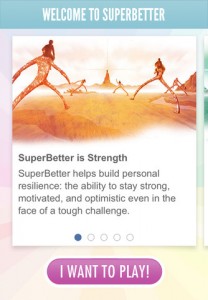 SuperBetter, a popular health and wellness game.
SuperBetter, a popular health and wellness game.
Three trends are driving players in the healthcare space -- especially insurers -- toward gamification, according to a recent report by consulting firm ICF International: the trend toward value-based care, the increasing role of the patient as consumer, and the millennial generation as desirable health insurance customers. A fourth trend, the increased proliferation of smartphones and tablets, wasn't cited in the report but seems to underscore its conclusions.
In the report, titled "Gaming to Engage the Healthcare Consumer," the authors write about how the use of gamification, which they define as "the application of game elements and digital game design techniques to everyday problems such as business dilemmas and social challenges," is on the rise in many industries, not just healthcare. They cite Gartner projections that by 2015, 50 percent of organizations will be using gamification of some kind and in 2016, businesses will spend $2.6 billion on gamification.
The ICF report describes why value-based care encourages gamification. Value-based care is driving the industry toward more of a focus on prevention, and prevention of diseases like diabetes or cardiovascular disease often involves changing behavior, an area where games show promise.
As healthcare organizations move toward business-to-consumer models -- rather than insurers, providers, and employers merely interacting with each other -- gamification can help them make their product attractive to those consumers.
Finally, the authors write, the 18 to 27-year-olds who have grown up with gaming (the millennial generation) are now one of the most sought-after demographics for health insurers. This is because they're a very large group -- they account for 38 percent of uninsured Americans -- and they are generally healthy, which makes them cheap to insure.
The report gives some guidance about developing games and gamified apps for health.
"Developing games with clear instructional objectives and measurable learning outcomes requires work -- not just play," the report says. "Success in this space requires a team of multidisciplinary, multifaceted experts, including advisors in healthcare, instructional design, research, assessment, and game design. Additionally, the team must have a proven methodology to apply these concepts to a fun and engaging game style."
Health Populi blogger Jane Sarasohn-Kahn, in her write-up of the report, picked up on that theme, stressing that building good gamified technologies requires the cooperation of developers, providers and, especially, consumers.
"When the behavior change that’s targeted is the person, she/he must be consulted at Phase 0, and ongoing, for keeping the team user-centered," she writes. "The same goes for tools meant for clinicians to use."
Games for Health conference organizer Ben Sawyer said this summer that healthcare is still waiting for the breakaway game that will take health gaming into the mainstream. He also alluded to a fourth reason the time might be right for gamification of healthcare, one not discussed in ICF's report: the ubiquity of mobile devices. Because they are always on us and can be picked up and accessed in a moment of spare time, mobile devices are an enabling platform for the development of behavior-changing health games.


















